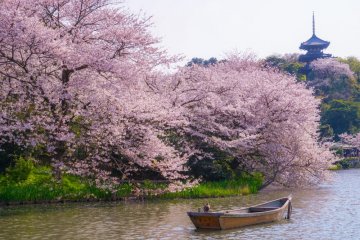

Known in Japanese as ‘Negishi Shinrin Koen’, this is one of the largest parks in Yokohama with a surface area covering over 1800 square meters. Originally built as a racing track in 1867, it was home to the first western style horse racing in Japan. However, after the Second World War it was redeveloped into a golf course by occupation forces. Its fortunes were changed once again in 1977 when it was officially opened by Yokohama city as Negishi Forest Park.

In 1859, when the port of Yokohama opened to foreign trade, silk was the country's largest export. In 1909, Japan was the world's premier silk supplier, serving markets such as the United States and Europe. Sankeien was built by Hara Sankei, a great entrepreneur who produced and traded silk in Yokohama. In the early 1900s, he used some of his wealth to create a Japanese garden over the course of about 20 years. The Sankeien covers approximately 175,000 square meters and extends over three valleys along the coast. It consists of an outer garden that has been open to the public since 1906 and an inner garden that was originally kept private for Sankei's personal use. Seventeen historic structures that have been relocated from Kyoto, Kamakura and other locations have been brought into harmony with nature over the four seasons to present great landscapes.

Yokohama Chinatown, also known as Yokohama Chukagai, is Japan’s largest Chinatown. An enclave of Chinese shops and restaurants has stood in this section of Yokohama since the port city was opened to international trade in 1859. The entrance to Chinatown is marked by four intricate and colorful gates, which represent the four directions in Chinese tradition. Each gate is associated with a different mythological animal an additional five gates stand within the neighborhood’s boundaries. More impressive architecture can be found at the Kanteibyo temple (also known as the Guan Gong Temple), which is dedicated to the Chinese god of successful business and prosperity. Built in 1873 by the neighborhood’s residents, it remains popular among the faithful and also welcomes visitors with its serene evening lantern displays. Nearby Masobyo Temple is newer and smaller, but this Taoist temple still impresses with its decorative touches. Chinatown is noted for its cuisine, from humble street stalls to gourmet feasts. Pork or mustard green steamed buns, egg tarts and goma-dango (sesame seed dumplings) all make for popular pick-me-up streets to grab on the go. In the many eateries that line the neighborhood streets, it’s possible to dine on any number of authentic Chinese dishes – spicy mapo tofu, duck, and dozens of dim sum options are just a few of the popular menu items on offer. Several stores in the area offer a unique shopping experience not often found in other Japanese cities. Pick out the perfect good luck charm or try your luck at a fortune teller. Browse the selection of one-of-a-kind “qipao”, a type of traditional Chinese dress. Or, stock your cabinet with a range of Chinese teas. Yokohama Chukagai sees its greatest influx of visitors every winter during the fifteen-day-long Chinese New Year festivities. The neighborhood is justifiably famous for its lavish celebrations, with lion dances, parades and numerous other activities. The streets are often decked out in lanterns and paper dragons; night visits are extremely atmospheric during this season.

Yokohama Stadium is located in Naka-ku, Yokohama, and is a multi-purpose stadium. These are quite rare these days. Yokohama Stadium opened in 1978 and can seat over 30,000 people. Today the stadium is primarily used as a baseball stadium Home field of the Yokohama DeNA BayStars, but American football games and live events also take place there. The stadium hosted an Australian rules football game and attracted the second largest crowd for such an event outside of Australia. Numerous artists are already performing in Yokohama Stadium: Santana, Michael Jackson, Tina Turner, Madonna, Luna Sea, Nana Mizuki and ONE OK ROCK are just a few of the well-known names.